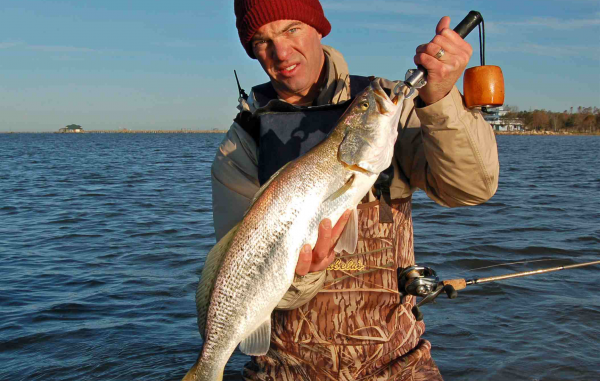
Drost specializes in trophy speckled trout
Will Drost specializes in catching trophy trout, but he uses his boat pretty much for scouting and transportation only.
In this excerpt from Trout Masters: How Louisiana Anglers Catch the Lunkers, the Big Lake wade fishing specialist talks about his love of big specks and how he fishes for them.
“I have crossed over to the other side,” said Will Drost, in a distinctively Star War-ian reference. “I have crossed over the line. I’m a wade fisherman.”
An athletic 6-feet, 5-inches tall, with closely cropped hair, tanned face and the manners and grace of someone born to privilege, he looks like anything but Darth Vader. Drost explained how he became a wade fisherman, and at the same time provided a primer on Calcasieu Lake and its fishermen.
Drost is a trophy-trout fanatic, and he has the notches on his gun to prove it. Numerous pictures of him and his fishing partners standing thigh-deep in the water holding outrageously large trout have graced the covers of Louisiana Sportsman and other magazines over the years. Besides his other accomplishments, Drost is a superb photographer.
Drost wade fishes from mid-October into July, but maintains that the best fishing is in the coldest months of December and January. Like many other Calcasieu Lake fishermen, he believes that speckled trout leave the lake’s shallow waters during the hot season. Where they go is the subject of a lot of speculation.
On a recent outing, Drost began fishing with a white Zara Super Spook with a chartreuse head, but changed lures constantly, selecting new choices from the fanny pack on his wading belt. All the lure-changing was facilitated by his use of Norton No. 10 twist-on snaps, which he uses without a swivel. When asked what his favorite bait is, he says “right now it is a Corky Fat Boy,” a suspending bait, which he admits can be hard to find.
As for lure color, in clear water he likes any pink color combination. In “off-colored water,” he uses chartreuse combinations, and in muddy water, he prefers chartreuse or darker-colored lures. He allows that in the very clear waters of winter, he does well with pearl combinations as well. In winter months, Drost fishes the Fat Boy slowly, but in warm weather he really rips it.
He describes himself as part of the “Top Dog generation,” and still fishes with She Dogs, as well as Catch 2000s, Thundersticks, Slapsticks and Super Spooks. His second-favorite bait is a solid-black Super Spook, which he loves to fish in clear-water conditions. Drost never uses soft plastics or live bait when wading for big trout.
Drost attributes his Olympian-distance casts partly to his use of 20-pound-test PowerPro braided line, which he says has the diameter of 6-pound-test monofilament.
“Thirty-pound-test PowerPro is terrible for backlashes,” he said, “but 20-pound is great.”
Drost’s casts are so long that he begins quick-retrieving his bait for another cast at about what would be the maximum distance that most anglers reach on the end of a cast.
His rod choice is a 7-foot Waterloo, a stiff rod with a fairly light tip.
“I want to cast as far as possible every time I cast,” Drost said. “Also, weight is an issue for me because of the way I fish. I like a light rod.”
His reel of choice is a Shimano Core baitcaster.
Drost uses a 7-foot monofilament leader in either 20- or 25-pound-test Trilene Big Game line. He dislikes flourocarbon for a leader because it makes bigger knots that hit the rod guides. Anything that interferes with distance casting is his enemy.
One thing noticeably missing from his belt is a stringer.
“I am a huge believer in catch and release,” he flatly states. “My releasing a 9-pounder may be the only way I’ll catch a 10½-pounder later.
“I realize that biologically those big trout are near the end of their life, that other things eat trout, that they are stressed by fighting while being caught and that multiple catches increase stress. Still, the best chance of making an even bigger trout is by releasing a big fish. I don’t have a problem with mounting fish, although fiberglass reproductions are identical to real fish.”
Will Drost’s tips
1) Put in the time. Regardless of whether you fish from a boat or by wading, there is no substitute for putting in the time. Drost says that his Texas friends call it “grinding.”
2) Always be alert. Look for bait species. Be aware of developing slicks. Often you can hear a trout hit that you don’t see.
3) Use big baits. They catch bigger fish.
4) Learn about your quarry. Read about fish biology. Study the fish when you are not on the water.
5) Talk to other trout anglers. Don’t ask them where they caught their fish or what they caught them on. Rather, ask them what they look for to find fish.
6) Develop a short-list of friends to compare notes with. This is especially important for telling you where not to go at any particular time.
Learn more about how the best guides and anglers across the Louisiana coast catch trout day in, day out by purchasing the Trout Masters Tool Kit, which includes a special package price for Trout Masters: How Louisiana’s Best Anglers Catch the Lunkers and Trout Masters Too: How the Pros do it.


